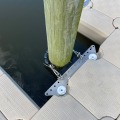Welcome to our ultimate guide on hardware replacement for Dock Construction near Folly Beach SC! Whether you're a dock owner, contractor, or simply interested in the maintenance and repair of docks, this article is for you. In this comprehensive guide, we'll cover everything you need to know about hardware replacement for Dock Construction near Folly Beach SC, from the basics to advanced techniques. So, grab a cup of coffee and get ready to dive into the world of dock maintenance and repair with us. By the end of this article, you'll have a thorough understanding of hardware replacement and how to use it to keep your Dock Construction near Folly Beach SC in top shape.
So, let's get started!Regular hardware replacement is crucial in maintaining the lifespan of your dock. With constant exposure to water and harsh elements, the hardware on your dock can deteriorate over time, leading to safety hazards and potential damage to your boat or watercraft. It is recommended to regularly inspect and replace hardware as needed to ensure the structural integrity of your dock. There are various types of hardware used in dock construction, including bolts, screws, brackets, and connectors. These hardware pieces are typically made from corrosion-resistant materials such as stainless steel, galvanized steel, or aluminum.
Choosing the right materials for your hardware replacements is essential in ensuring longevity and durability. To begin the process of hardware replacement, you will need to gather the necessary materials and tools. This may include a drill, screwdriver, hammer, and replacement hardware pieces. It is also helpful to have a diagram or plan of your dock's layout and the location of each hardware piece. The first step is to remove the old hardware by unscrewing or drilling out any bolts or screws. If the hardware is rusted or stuck, you may need to use a rust penetrant or heat source to loosen it.
Once removed, thoroughly clean the area and remove any remaining debris. Next, align the new hardware piece with the designated spot on your dock and secure it in place using a drill or screwdriver. Be sure to use the appropriate size and type of screws or bolts for your specific hardware piece. Visual aids such as diagrams or photos can be helpful in understanding the proper installation process. If you are unsure or unfamiliar with dock construction, it may be beneficial to consult a professional for assistance. The cost of building a dock can vary depending on its size, location, and materials used. However, regular maintenance and timely hardware replacements can save you money in the long run by preventing more significant repairs or even complete dock replacement. When choosing hardware for your dock, consider factors such as the type of water and weather conditions, the weight of your boat or watercraft, and the overall design and layout of your dock.
It is important to select hardware that is specifically designed for marine use and can withstand the elements and constant water exposure. In conclusion, regular hardware replacement is crucial in maintaining the safety and longevity of your dock. By understanding the different types of hardware used in dock construction, gathering the necessary materials and tools, and following proper installation techniques, you can ensure that your dock remains in top condition for years to come.
Choosing the Right Hardware for Your Dock
When it comes to building or repairing a dock, one of the most important factors to consider is the type of hardware you will be using. The right hardware can make all the difference in terms of safety, durability, and functionality for your dock. There are several factors to keep in mind when selecting hardware for your specific needs:- Material: The material of the hardware should be able to withstand the harsh marine environment, including saltwater, UV rays, and constant exposure to moisture.
- Type of Dock: The type of dock you have will also determine the type of hardware you need.
For example, a floating dock will require different hardware than a stationary dock.
- Weight Capacity: Consider the weight capacity of the hardware and ensure it can support the weight of your boats or watercraft.
- Installation Method: Some hardware may require special tools or expertise for installation, so consider this when making your selection.
Why is Hardware Replacement Necessary?
Regular maintenance is essential for any structure, especially for something as important as a dock. This includes the replacement of hardware such as bolts, screws, and hinges. While it may seem like a small task, neglecting to replace hardware can have serious consequences. First and foremost, regular hardware replacement ensures the safety of those using the dock. As boats and watercraft are constantly coming and going, the dock needs to be secure and stable.If hardware is worn out or damaged, it can lead to accidents and injuries. By regularly replacing hardware, you can prevent potential hazards and keep everyone safe. Another reason why hardware replacement is necessary is to maintain the longevity of the dock. Exposure to water and other elements can cause hardware to rust and corrode over time. This can weaken the structure and ultimately lead to costly repairs or even the need for a complete replacement.
By regularly replacing hardware, you can extend the lifespan of your dock and save yourself time and money in the long run. Lastly, regular maintenance and hardware replacement can also improve the overall appearance of your dock. Worn out or damaged hardware can make your dock look unsightly and decrease its value. By keeping up with hardware replacement, you can ensure that your dock looks well-maintained and attractive.
Step-by-Step Guide to Replacing Dock Hardware
Replacing hardware on a dock may seem like a daunting task, but with the right tools and instructions, it can be a smooth and successful process. Here is a step-by-step guide to help you through the replacement process.Gather the Necessary Tools and Materials
Before starting the replacement process, make sure you have all the necessary tools and materials.This may include a screwdriver, pliers, hammer, nails, screws, and new hardware pieces. It is important to have the correct size and type of hardware for your specific dock.
Remove Old Hardware
The first step in replacing dock hardware is to remove the old hardware. Use a screwdriver or pliers to carefully remove any screws or nails holding the hardware in place. If the hardware is rusted or stuck, you may need to use a hammer or lubricant to loosen it.Clean the Area
Once the old hardware is removed, clean the area where the new hardware will be installed.Use a wire brush or sandpaper to remove any rust or debris. This will ensure a clean surface for the new hardware to be installed on.
Install New Hardware
Now it is time to install the new hardware. Follow the manufacturer's instructions for proper installation. Use the correct size screws or nails and make sure the hardware is securely attached to the dock.Test and Adjust
After all new hardware is installed, test it out by gently pulling or pushing on it.Make any necessary adjustments to ensure that the hardware is secure and functioning properly.
Dispose of Old Hardware
Properly dispose of the old hardware. This may include recycling or throwing away any rusted or damaged pieces. Following these easy-to-follow instructions will ensure a successful replacement process for your dock hardware. Remember to always use caution and wear protective gear when handling tools and materials.Types of Hardware Used in Dock Construction
Dock construction requires the use of various hardware to ensure stability, durability, and safety. Each type of hardware serves a specific function and plays a crucial role in the overall structure of the dock.In this section, we will discuss the different types of hardware used in dock building and their functions.
Piling Caps
Piling caps are used to protect the top of wooden or concrete pilings from water, weather, and other elements that can cause damage. They also add a decorative touch to the dock.Galvanized Bolts and Nuts
Galvanized bolts and nuts are used to connect different sections of the dock together. They are resistant to corrosion and provide a strong and secure connection.Joist Hangers
Joist hangers are used to support the joists that hold the deck boards in place. They are typically made of galvanized steel and are designed to withstand heavy loads.Decking Screws
Decking screws are used to secure the deck boards to the joists.They come in different sizes and materials, including stainless steel, galvanized steel, and coated steel, to withstand exposure to water.
Cleats
Cleats are used to tie up boats or watercraft to the dock. They are typically made of galvanized steel or aluminum and come in different sizes depending on the size of the vessel they will be holding.Fenders
Fenders are used to protect the dock and boats from damage caused by contact with each other. They are typically made of rubber or foam and come in various shapes and sizes.Mooring Whips
Mooring whips are used to secure boats to the dock and prevent them from hitting the dock or drifting away. They are typically made of fiberglass and come in different sizes depending on the size of the vessel they will be holding.Anchor Chains
Anchor chains are used to secure the dock to the bottom of the water body.They come in different lengths and sizes, depending on the depth of the water and the size of the dock.
Hinges and Latches
Hinges and latches are used to attach and secure gates and other movable parts of the dock. They come in different sizes and materials, including stainless steel, galvanized steel, and aluminum.Floatation Devices
Floatation devices are used to keep the dock afloat and provide stability. They are typically made of plastic or foam and come in various shapes and sizes depending on the size of the dock. In conclusion, hardware replacement is a crucial aspect of maintaining your dock's lifespan. By regularly checking and replacing worn-out hardware, you can ensure the safety and longevity of your dock.We hope this guide has provided you with all the necessary information and tips to make the hardware replacement process a breeze.






